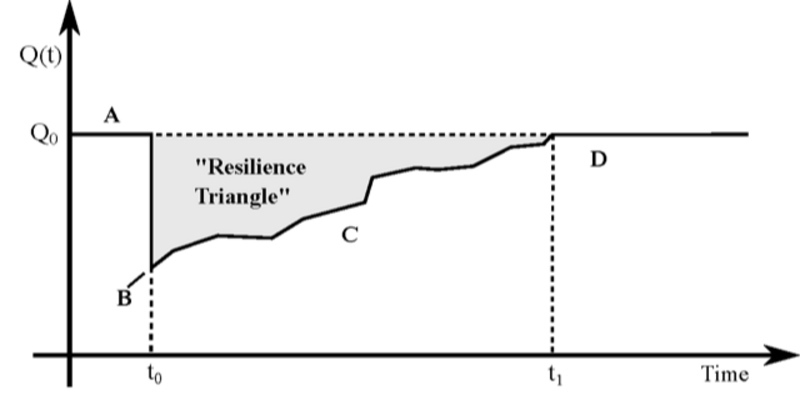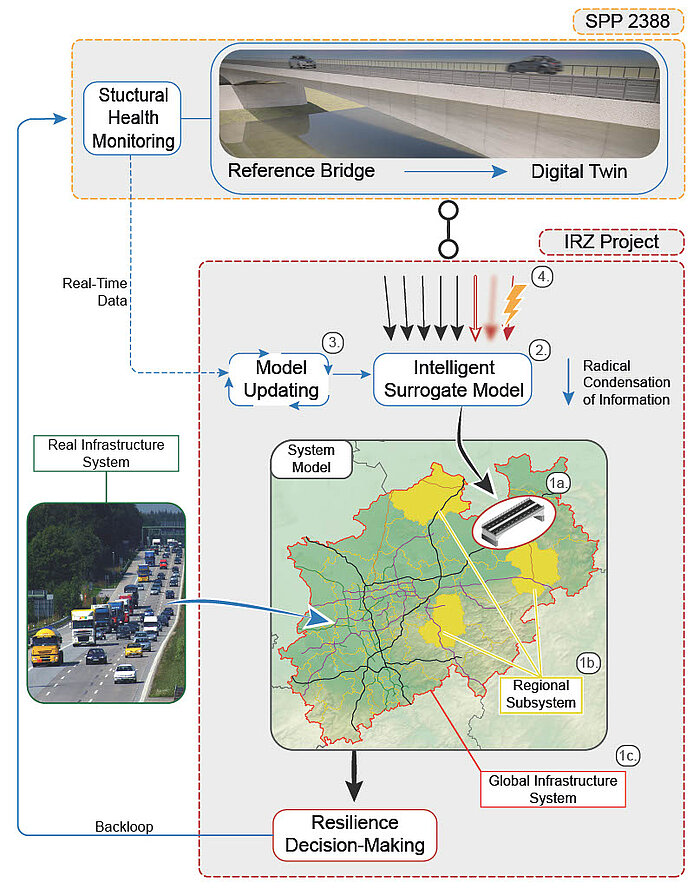Intelligent resilience analysis for infrastructure considering uncertain real-time data
Comprehensive yet efficient numerical modeling and analysis tools for large and complex infrastructure systems are becoming increasingly important for modern societies. In the current project, according developments are integrated into a comprehensive infrastructure resilience framework taking into account cost and uncertainty of various resilience enhancing decision paths. According to Fig. 1, the resilience is quantified based on the time-dependent system performance Q(t) in the presence of disruptive events and degrading effects over the full life cycle. The “resilience triangle” in a single period is characterized by (A) the reliability, (B) the robustness, and (C) the recoverability of the system, as illustrated in Fig. 1, and corresponding improvement measures.
The multidimensional optimization of resilience enhancing decision paths enables cost-effective decision-making for stakeholders in terms of risk prevention as well as maintenance, repair, and overhaul planning. Thereby, the framework allows the crucial consideration of systemic interactions. Key challenges for a realistic analysis include interconnecting numerous models and performance measures at all system levels, analyzing the massive data sets available for critical structures or generated from Structural Health Monitoring (SHM), and accounting for the inherent uncertainty in all available data.
As illustrated in Fig. 2, several system levels are identified at different scales - (1a.) critical technical structures form basic system components, (1b.) regional subsystems represent spatial and functional connectivity, (1c.) all sub-models are aggregated at the global infrastructure system level. This sub-structuring approach not only facilitates the handling of the resulting computational complexity for large infrastructure systems, but also enables precise localization of critical regions and components. At the component level, (2.) an intelligent surrogate modeling procedure based on automated machine learning is developed to condense the vast amount of data available for the SPP 2388 reference bridge into a probabilistic, time- & state-continuous surrogate model. A corresponding (3.) model updating procedure fits the real-time data collected by SHM to the surrogate model to ensure accurate predictions.Uncertainties arising from (4.) conflicting, vague, or incorrect (real-time) data will be quantified and propagated through the systemic model. At the regional subsystem level, critical infrastructure components are linked and integrated into a newly developed system reliability model that enables comprehensive yet efficient numerical analyses. Further reduction of the complexity of subsystem models is achieved by clustering similar components into component types.
Information resulting from subsystem reliability modeling is integrated into the developed life cycle resilience decision-making framework, including recovery models and cost functions.
This overall framework will enable decision-makers to make cost-efficient life cycle decisions in maintenance, overhaul and repair planning as well as design processes, considering component lifetimes and monetary constraints. The developed approaches on component level are demonstrated for the reference bridge "Nibelungenbrücke Worms" (Bundesstraße 47). On the system level, the surrounding infrastructure system is considered, whereby the counties are divided into regional subsystems and physical properties of further critical structural components are assumed for demonstration purposes.







